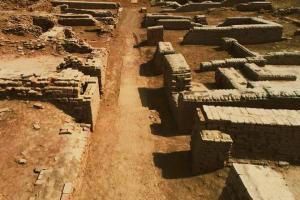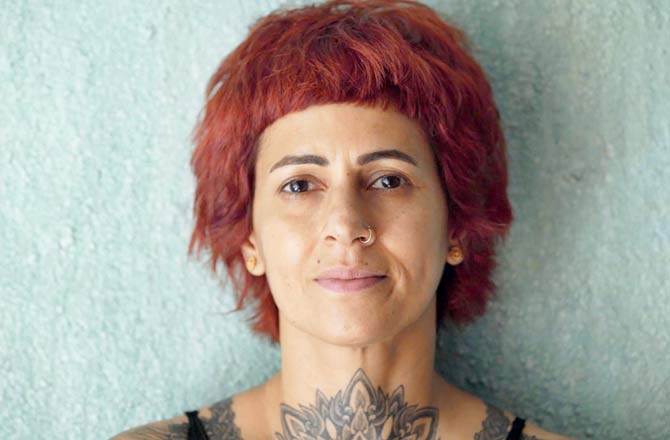Hairstylist Sapna Bhavnani's docu drops online, revisiting the largest migration of a culture in the world, through her body

Punjab-Sindh-Gujarat-Maratha, Dravida-Utkala-Banga.' Singing the national anthem, during the morning school assembly, as a six-year-old, was how I was first acquainted with my country's diversity. I remember poring over the map of India, to find the places that we sang paeans about. Sindh was impossible to locate. For that, my teacher later informed, I'd have to seek outwards, in the neighbouring country of Pakistan. A place my eyes had never travelled to, until then.
ADVERTISEMENT
Celebrity hairstylist Sapna Moti Bhavnani's documentary, Sindhustan, also draws from her own ignorance of Sindh, where her ancestral roots lie. "All I knew about my culture was Sindhi kadi," says Bhvanani in the film, that she has also co-produced. The hour-long film is both a physical and meditative invocation of her lost roots and land.
Two years ago, Bhavnani turned her body into a canvas, tattooing the journey her Sindhi ancestors had undertaken via land, air and sea, in the wake of the Partition. Refugees, as they were, many of them found themselves a home in bustling Bombay, a far cry from the mystical land, where the Sufis from Iran had settled. "I was 36 years old, when I realised, I was the daughter of a refugee," says Bhavnani, in the opening lines of the film. "I remember being at this concert, watching some fakirs from Sindh perform. And I was so blown away, that I ran home and Googled Sindh for the first time. When I found out this was the largest migration of a culture in the history of the world—and I had no idea being a Sindhi—I knew it was time to start [making this film]."

Sapna Moti Bhavnani in Sindhustan
Bhavnani's body is a recurring trope in this documentary, an imagery of the pain and anguish that her relatives and other Sindhi families experienced, having been forced to abandon home and hearth, and seek the unfamiliar. The motivation to tattoo her body, and make this film, were intrinsically tied. When Bhavnani was denied a visa to visit Sindh, she decided to "become the land". "My legs carry the story of their journey, and my feet the lack of our roots," she shares. In the film, the hairstylist recounts the time when she had just started getting herself inked, and had to cover up, before meeting her grandmother for lunch. "You are so old-fashioned, Sapna," her grandmum had chided her, amused that she was hiding the tattoos. "When we first came on this planet, we lived in tribes. We didn't have countries, boundaries and governments. We lived as extended families. We all had markings that signified where we belonged. I see your ink, and I see you're going back to your roots...our roots!" she was told.
But this journey of uprooting is not just told through the body, alone. Bhavnani brings together diverse voices that revisit their land of yore. There is her aunt from whom we learn the recipe for the delicious Sindhi kadi. Scholar Jairam Rupani shares how Sindhis are given to speak so loudly that their voices can travel to other villages. There is, of course, the tormenting experience of migration; Partition survivor Sundar Nachnaney was slapped by an immigration officer, when he answered him back. The pain still lingers, he says. Most delightful is the story of Dr Sundari Keswani. "Do you miss Shikarpur?" Bhavnani asks her, of her erstwhile hometown. "Yes…" says the old woman, adding, "A river used to flow. Still must be flowing, no? I can never forget…I am Shikarpuri."
Bhavnani's storytelling is nuanced, and draws from the self. That she is heavily inspired by 18th century Sindhi poet and mystic Shah Abdul Latif is visible—his words resound through her work, sometimes radiating sadness, but also often hope. I wonder, if it's her body that is the story, and not the land. But as she says, sometimes that's also "the best way to tell a story."
Available on: www.moviesaints.com/movie/sindhustan
Catch up on all the latest Mumbai news, crime news, current affairs, and a complete guide from food to things to do and events across Mumbai. Also download the new mid-day Android and iOS apps to get latest updates.
Mid-Day is now on Telegram. Click here to join our channel (@middayinfomedialtd) and stay updated with the latest news
 Subscribe today by clicking the link and stay updated with the latest news!" Click here!
Subscribe today by clicking the link and stay updated with the latest news!" Click here!






